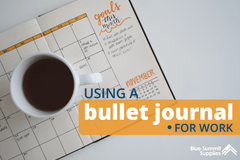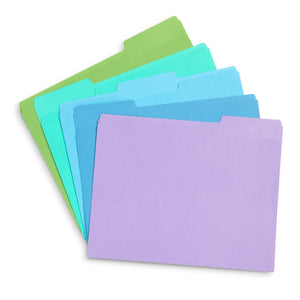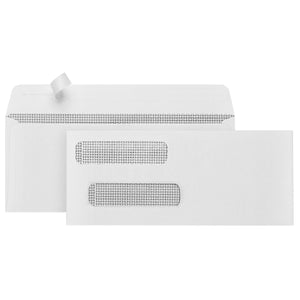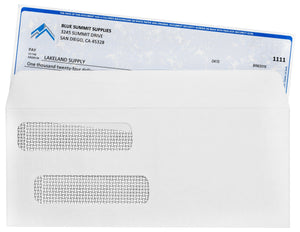Sending and receiving emails can feel daunting, especially when you’re corresponding with a higher-up. Don’t let it overwhelm you – our guide on email etiquette in the workplace will help get your emails in great shape before you hit ‘send.’
As an added bonus, we’ve created a free downloadable printable Email Etiquette Cheat Sheet you can keep at your desk!
 |
Click here to download our free email etiquette cheat sheet! |
The Anatomy of an Email
Save yourself stress and keep the format of your emails simple. Here’s the ‘rule of thumb’ template:

Common Misspellings
Spellcheck and Grammarly are your friends, but you may not always have time to use them. Protect yourself from potential embarrassment by familiarizing yourself with the proper ways to spell these commonly misspelled words.
- Definitely. This word is often mixed up with the word ‘defiantly,’ which has a completely different meaning. If you get confused, sound it out – def-in-it-ely.
- Separate. It may feel wrong to type an ‘a’ where you want to put an ‘e,’ but separate yourself from the discomfort and get this word right.
- Recommend. This word is tricky since it has a pair of double consonants, but it’s just one pair. Remember, we recommend you only use one ‘c’ in recommend.
- A lot. A lot of people will cram these two little words together to create the nonexistent word ‘alot.’ For a thorough overview on why ‘alot’ is such a silly and preventable offense, check out this Hyperbole and a Half comic.
- Receive. The rule ‘I before E except after C’ doesn’t always apply in the English language, but it does here. You’ll receive a gold star if you spell this one right.
- Definite. It’s definite that there are no ‘a’s in definite.
- We’re all e’s – dependent has no a’s.
- Calendar. Mark your calendar since you’ll always remember calendar has two a’s from this day on.
- Spelling correctly is a right, not a privilege. Remember that this word has two of each – two i’s and two e’s.
- When discussing prospective clients or deals, make sure you get this one right! ‘Perspective’ is a completely different word.

This vs. That
Homophones are words that sound alike but mean different things. In writing, there can be ‘written homophones’ – words that sound or look similar but have different meanings. Here are some of the most commonly confused words and their correct meanings.
Lose vs. Loose
Remember, you lose points for misspelling ‘lose.’ Two o’s turns ‘lose’ into ‘loose,’ and that’s a different word altogether. To ‘lose’ something means to misplace or no longer possess it. To ‘loose’ something means to loosen it up or set it free. Make sure to get this one right, or you might lose prospective clients!
Affect vs. Effect
The best rule of thumb is this: affect is a verb and effect is a noun. You would write ‘the effect affected me.’
They’re vs. Their vs. There
One of the most common mix-ups, these homophones sound the same with very different meanings. They’re is a contraction meaning ‘they are.’ Their is a possessive pronoun meaning that which belongs to them. And there is a word meaning “in, at, or to that place or position.” There, is that so hard?
You’re vs. Your
You’re is a contraction meaning you are. Your is a possessive pronoun meaning that which belongs to you.
i.e. vs. e.g.
These two are tricky since their meanings are similar but different. They are both shorthand for Latin phrases. I.e. stands for ‘id est’ and means ‘in other words,’ so it should be used to restate what you’ve said. I.e., ‘id est’ is a lead-in to a simplified explanation.
E.g. stands for ‘exampli gratia’ which means ‘for example.’ E.g. you would use e.g. to list off examples of something, like so: Apples can come in many colors, e.g. red, green, and yellow.
It’s vs. Its
It’s is a contraction meaning it is. Its is a possessive pronoun meaning that which belongs to it.
To vs. Too
According to Grammarly, “To is a preposition with several meanings, including ‘toward’ and ‘until.’ Too is an adverb that can mean ‘excessively’ or ‘also.’” Don’t forget to spell the number two correctly, too.
Sense vs. Since
These words sound similar but have very different meanings. According to WSU, “’Sense’ is a verb meaning ‘feel’ (‘I sense you near me’) or a noun meaning ‘intelligence’ (‘have some common sense!’). Don’t use it when you need the adverb ‘since’ (‘since you went away,’ ‘since you’re up anyway, would you please let the cat out?’).
I vs. Me
Sometimes in our bid to sound educated, we misuse words. When it comes to ‘I and me,’ remember this: ‘I’ is the subject of the sentence, and ‘me’ is the object. ‘Do you want to go get lunch with Matt and me?’ or ‘Matt and I are going to lunch, would you like to come?’
Bonus Tip: Singular Possessive vs. Plural Possessive
Singular possessive nouns are easy. If a person, place or thing owns something all you have to do is add an ’s. Here are some examples: Sandra’s dog is very cute. The boss’s car is orange. The jam’s ingredients are blackberry and blueberry.
So what is a plural possessive noun? Plural possessive nouns show ownership when there is more than one of a noun. To show ownership where there is more than one noun you can simply add an s’ to the end of a word. Here are some examples: The kittens’ toys are everywhere. There is more than one kitten in this instance. All of the books’ pages are ruined. (There is more than one book in this instance.)
There is one exception to this rule. If a plural noun does not end in an s then you would simply add an ’s. For example, since the plural noun women does not end in an s you would add an ’s to show possession. The women’s shoes are very expensive.
If you remember these few simple rules then you will have no problem mastering singular and plural possessive nouns!
Do’s and Don’ts of Email Etiquette
You’ve got the format down and your spelling and grammar is flawless. But what about tone and phrasing?
Communicating via the internet is notoriously difficult, since it’s not always easy to deduce tone over text. That being said, there are ways of phrasing delicate things that are better received than bluntness. This handy chart created by Dani Donovan gives a no-nonsense rundown of what to say when.
Some of us – women, in particular – are also guilty of over-sweetening our professional emails, usually through apologies, platitudes, and an excess of exclamation points. We understand that a simple ‘Thanks for the quick reply.’ can sound a bit stonier than ‘Thanks for the quick reply!’ but most people won’t read a period as harshly as you fear. Just being direct and confident is far more professional, and it doesn’t make you seem hard or mean. Generally, it’s best to use fewer words to get your point across, so keep that in mind when writing emails.
Here are a few more Do’s and Don’t’s when it comes to email etiquette in the workplace.
Do use a professional email address even if you aren't assigned one by an employer. If you're a contractor or applying for jobs, don't use partymonster42@hotmail.com; register a nice, professional Gmail account, for god’s sake.
Don't forget to always use proper grammar. Even in casual offices, emails aren’t the same as texts. It's still a professional environment. Use full sentences, correct punctuation, and proper signoffs. You never know when your old emails will be brought to light.
Do use clear, concise sentences and plenty of line breaks. A block of text can overwhelm your reader; breaking it up makes it wayeasier for people to read and understand.
Don't ask more than one question in a single sentence. Better yet, put line breaks between your questions.
Do review your emails at least once before hitting send. Does the email make sense? Is your grammar good? Does it need to be condensed? Do you have the right email addresses as recipients? And always check – did you attach your attachments?
Don't reply-all. There's a time and a place and unless everyone on the chain needs to see your response, avoid it.
Do flag or star emails you need to follow up on. You don’t have to always respond to emails right away; doing so can get exhausting. Allow yourself the freedom to designate specific email-checking and replying times using a method like the Pomodoro method. You’re entitled to enjoy your evening at home or stay unplugged on a vacation. Just make sure you don’t let emails slip through the cracks.
Don't forget to follow up. You don't have to answer right away but you DO need to answer. Set aside time to filter your emails by flagged/starred emails and make sure nobody is awaiting a reply.
Do use vacation autoresponders when you're out of the office. Make them short and sweet and provide contact info for a colleague if they need immediate assistance. And don'tforget to turn it off when you get back!
Don't respond to emails when you're angry or upset. Wait until later or even the next day so you have time to sort through your thoughts.
Do write drafts of difficult, long, or extra-important emails in a Word document or an unaddressed draft email. This makes it easier to proof and edit your words without accidentally sending it before you're ready.
Don't overdo it with the platitudes and exclamation points.
Do check to be sure you're emailing the right people. Autofill makes it easy to type in a couple letters and hit enter so you can accidentally email Kathy when you mean to email Karen.
Don't include an extra-long email signature. All they do is clutter up people's view and nobody gives a crap about your inspirational quotes.
The Magic of Unsend
Pro-tip: If you use Gmail, you can unsend emails! But be warned, unless you adjust your settings, you have a very brief window to do so.
Once you hit send, look to the bottom left of your screen. You should see a black bar that says ‘Sending…’ as the email sends. Once it has sent, it will say ‘Message Sent’ and you will see two options: ‘Undo’ and ‘View Message.’
To unsend the message, click ‘Undo.’ This will un-send the message and you will be able to edit it in your drafts before sending it out!

What words constantly trip you up? Do you have any good stories about email gaffes? We want to hear! Leave a comment or reach out on Twitter, Instagram, or Facebook. And as always, send us an email with any questions or comments– Larry loves to hear from you!
 For more informative articles about office supplies, subscribe to our email newsletter!
For more informative articles about office supplies, subscribe to our email newsletter!
Never fear, you won't begin receiving daily sales emails that belong in a spam folder. Instead, we promise a fun weekly roundup of our latest blog posts and great finds from across the web. And if you lose interest, it's always easy to unsubscribe with a single click.










